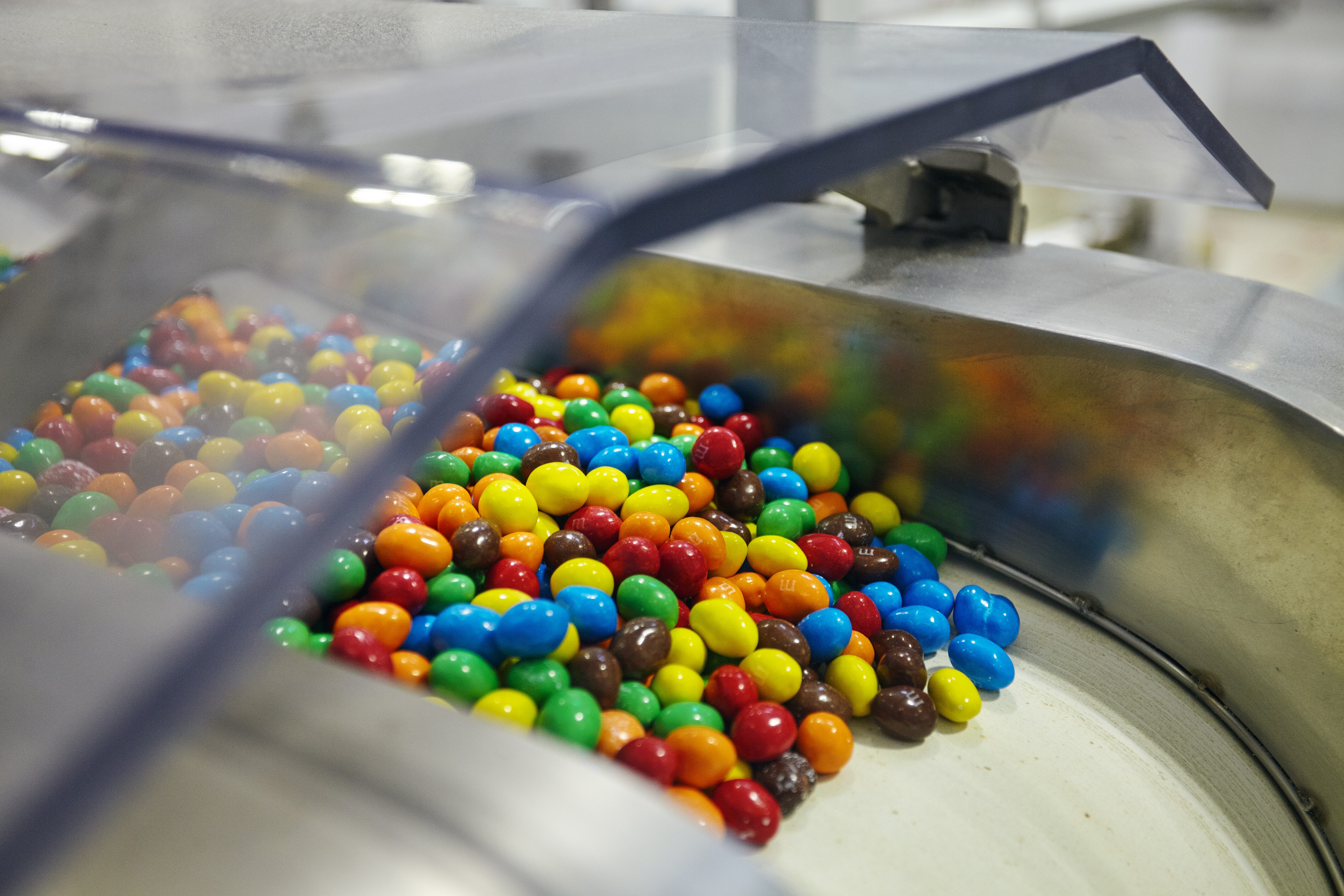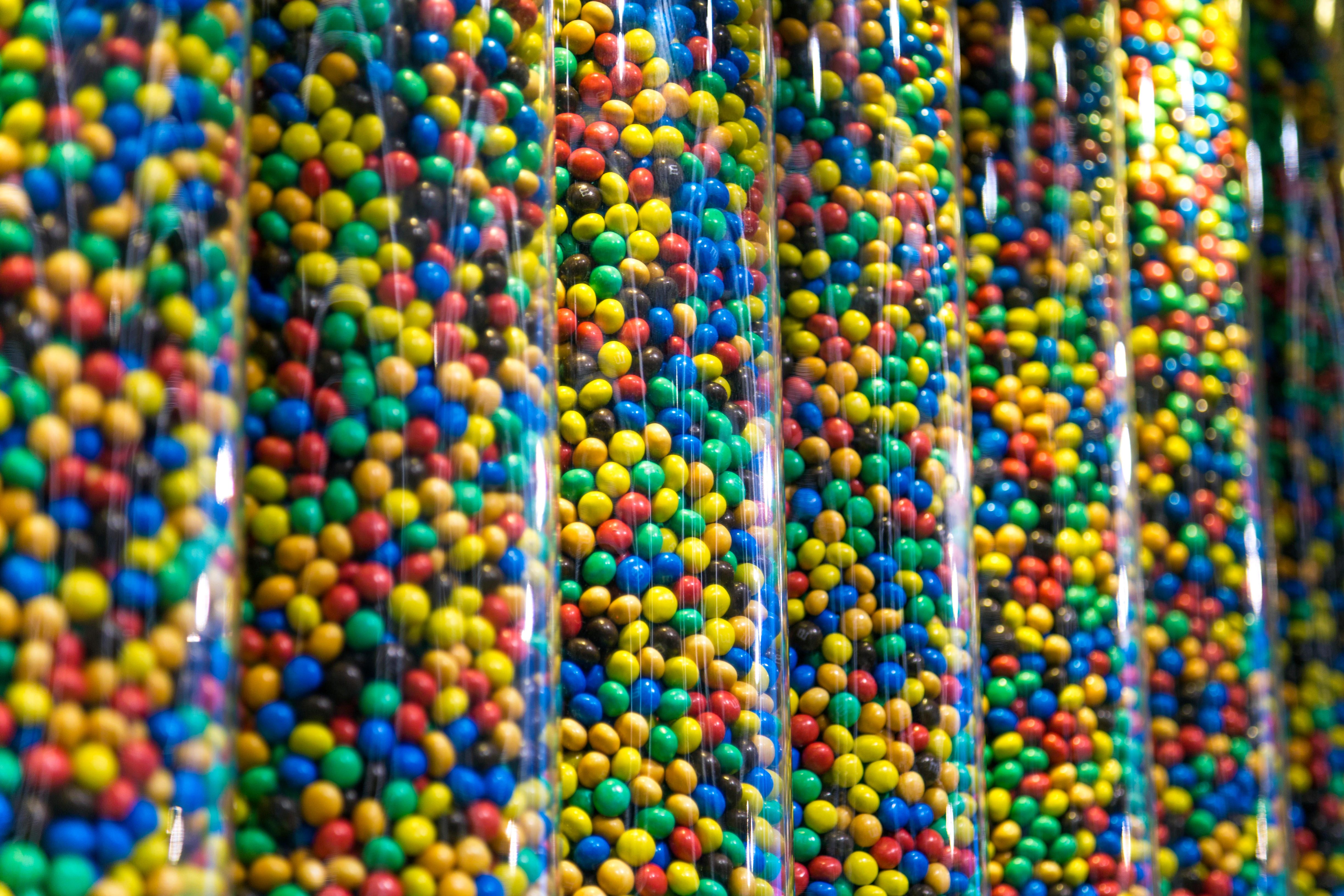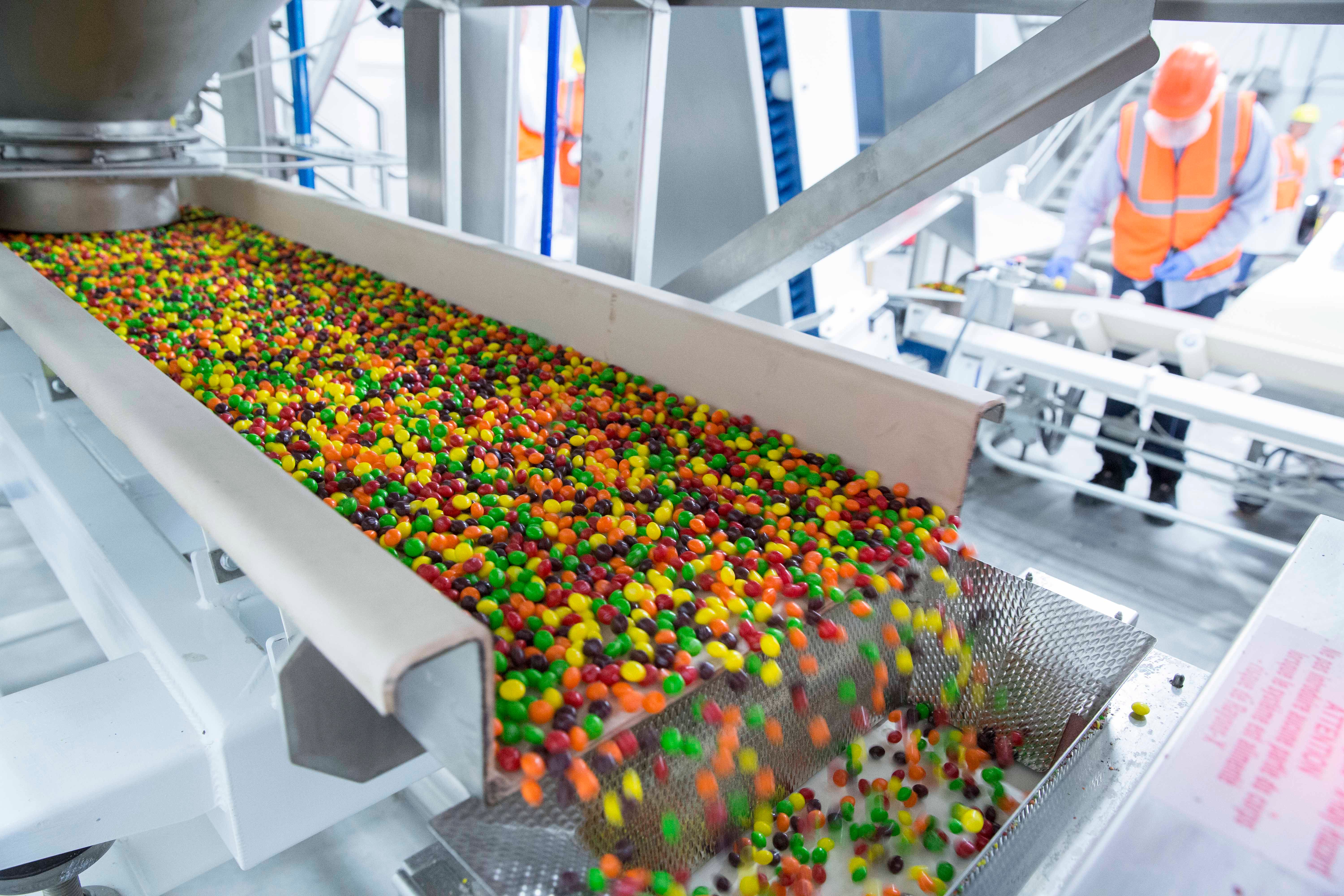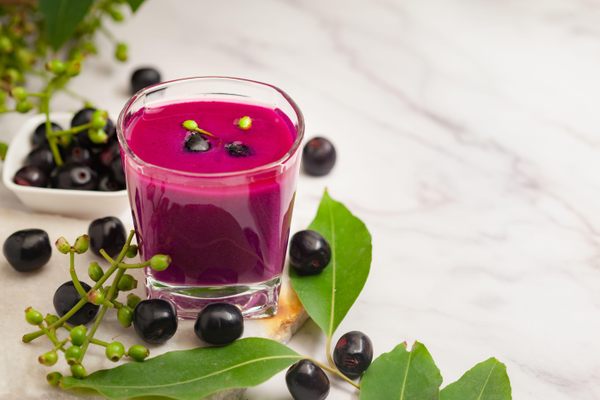Exit Interview: I Was the Director of Research and Development at a Candy Company
His proudest achievement? Putting your face on an M&M.

“Candy inventor” is a dream job. But what’s it like to be a real one, especially at a global, multi-billion dollar company?
Dan Michael knows. As the former R&D Director at Mars, the confectionery company, he spent a career developing a new jalapeño-peanut M&M flavor, figuring out how to produce Snickers in Russia after the fall of the Soviet Union, and solving the technical challenge of printing people’s faces on M&Ms.
After multiple decades of tinkering with candies, cookies, and snacks, it was this last effort—a product called My M&Ms, which allows customers to personalize their colorful chocolates with any message or image they please—that was his proudest accomplishment. Michael spoke with Atlas Obscura about marketers sneaking down to the prototype kitchen, snooping around in customers’ cabinets, and why Willy Wonka’s chocolate factory would go out of business.

Could you tell me about how you ended up working at Mars?
I have an 18-year-old son who’s applying to colleges, and I don’t think he really knows what he wants to be when he grows up. I didn’t either. I remember going to Rutgers University, and there was a dean who said, “If you kind of like science, but don’t want to do heavy-duty chemistry or biology, people need to eat, and there’s this thing called food science.” So I decided to learn how to be a food scientist. [A few years after graduation] I ran across an ad for Mars in the paper and applied. I joined up and stayed there for 28 years.
So you were something of a company man.
Yeah, you know, I had the mindset that I’ll give this a shot, but won’t stay a long time. But I gotta be honest with you, I just love Mars. They let me do all kinds of different things. I wouldn’t have stayed there for 28 years if I wasn’t having a ball.
Looking back, which new candy or product that you worked on do you feel the most proud of?
I was fortunate that I could finish my career with the product I love most, and that’s the My M&Ms brand. I worked on that for five or six years, from prototype to it becoming a pretty successful business for Mars. The reason I loved it is that M&Ms are about colorful chocolate fun, and this took it to a new level. It involved new technology as well. We built a new factory, what we called the Print Shop, to build these products. I’m very proud of how it turned out.
What was challenging about customizing M&Ms?
Our brands, M&Ms, Snickers, Mars, they’re all made on a large scale. You’re making one thing and you’re shipping it out. This was very different. You’re allowing the customer to come to the website and design the one thing. But we’re doing thousands of those one things a day.
There were a lot of challenges associated with the inkjet printing, too. Trying to make an image look good on a tiny little M&M, that involved a lot of technology. It took years.

I believe the origin story of M&Ms is that the inventor got the idea after seeing soldiers eating chocolate with a hard shell, which kept it from melting. Did you or your team ever have a similar eureka moment?
Certainly nothing as successful as the idea that led to the original M&M!
One development related to My M&Ms is that once we had the business up and humming, and people could put in their messages, we were looking at customer requests, and we would see a Harley Davidson. This guy loved his Harley Davidson. Can you print it on an M&M? This woman loves her husband. Can you print my husband’s face on an M&M? We weren’t doing that at the time because we didn’t know how to do it. We could print a message in Comic Sans on an M&M.
It was a kind of hard thing to figure out, as you can probably imagine, because people take poor quality photos with their phone or camera and you have to make sure it looks like something you’d be proud to have on an M&M. Faces on M&Ms is the lion’s share of our My M&Ms business [now], because it is just really cool.
Are your friends and acquaintances always trying to pitch you new ideas?
Yeah! Because it’s fun. “Have you ever thought of? Hey Dan, have you ever thought of? How about this?” The answer is usually, “Yeah, we have.” And that’s not a [slight] against them; a lot of people have good ideas. It’s usually about introducing something at the right time and place.
Roughly speaking, how many ideas are tested to get to one new candy or flavor that’s sold in stores?
At least at Mars, we’ve got these brands that have been around for years that people love. Our main focus is less bringing a new candy into the market, but creating news and interest around ones we have. You’ve probably seen that we release new M&M flavors. Sometimes we put it out to a consumer vote. That’s what we do more than coming up with a brand-new candy bar.
The success rate of new flavors is a lot higher than launching a brand-new product. We probably have hundreds of different ideas around our brands that we’ve held onto over the years. It’s really a luxury, because we can pull those ideas out and apply them when we see that the time might be right.
We don’t tend to say, “Let’s go invent a brand-new candy bar.” The top 10 candy bars haven’t changed in many, many years. What people like doesn’t really change that much. It’s great to come out with new stuff. But I highly doubt that a Mexican Jalapeño Peanut M&M is going to replace Peanut M&Ms as a big seller. It certainly has a place though.
So the Willy Wonka image of a chocolate factory, where the focus is always producing zany, brand-new things, is not a model that would do well in reality?
I don’t think so. And I don’t know that that’s a bad thing. The failure rate of brand-new stuff is really high. You’re talking 70, 80 percent, or even higher.

Are there any flavors or products that you’ve been always hoping you could get in stores, but remained elusive?
We didn’t invent this, but we borrowed this idea from what we’ve seen globally, especially in the Far East. It’s basically a peanut that’s coated in a cracker shell, and the cracker shell can be seasoned. It’s a really awesome product. I love peanuts; I love crispy-crunchy cracker shells; and I like the ability to be able to play with that shell however you want, whether that’s a honey nut or something really spicy. We actually did mini-launches of this idea in the U.S. But it just didn’t make great business sense at the time. It never went mainstream.
What are those testing sessions like when you demo a new candy?
There are a lot of ways to do it. We talk about it in terms of quantitative or qualitative. The way I like it, with qualitative, is you talk to even one person, one on one, and have a nice conversation and try to get insights from them.
We’ve also done stuff where you go into people’s homes and you look in their cupboards to see how they’re living.
Wait, when you poke around in their cabinets, what are you looking for? What are you trying to learn?
Other than just what type of products they have, you’re looking where they put them. Are they hiding those products over the refrigerator, in a drawer where their kids can’t get to them so they can be their little treat? I’ve seen that. It’s so obvious what they’re doing, and they say, “Yeah, that’s my secret stash. I don’t want the kids getting at that.” You learn all kinds of different things. You learn who your competition is. If they’re swapping crackers for cookies. It’s neat; a mystery that’s unfolding. It’s harder to set up than a focus group, but usually worth the effort.

I’m sure Mars is selling candy and products all over the world. Does China want something really different in a chocolate bar compared to the U.S.?
By and large we have taken our Mars candy products all over the world. In the ‘90s, we went into the Russian market and built a factory to build Snickers bars, and our goal was to build Snickers bars just like we did in the U.S. It became the top-selling bar in Russia. We feel strongly that our brands as they are have a lot of legs no matter where they are. It’s one recipe; you don’t have to redevelop stuff.
It’s less work for you though!
[Laughs]
How did you decide it was the right moment for Jalapeño Peanut M&Ms?
I bet if you go back in our archives, it came up 20 years ago as an idea. But that doesn’t mean it was a good idea then. Mexican jalapeño is a pretty topical flavor. But not as much in candy. A lot of the time, you borrow from other categories, and you realize it goes well with chocolate. Sometimes it may be an idea that was thought up a year ago; other times 10 or 20 years ago. There are a lot of things like that, for both savory and sweet flavors.
In the end, we’re trying to make products that our consumers love. It’s fascinating to me to figure out what consumers love by following trends or going to the consumer, whether that’s rummaging in their cabinets or just talking to them. I’m a big believer in prototyping to bring these ideas to life and then get them in front of consumers again. The consumer is our boss and we want to make them happy.
What is it like to prototype something? What’s it like to prototype a new flavor of M&Ms or Combos?
Our product development lab is basically a kitchen. We have Hobart mixers, kitchen utensils, you’d take chocolate and melt it and temper it, and you’d bake crackers or cookies. It’d be very very crude, but that was okay, because you’re just trying to get the general idea.

I just feel like if I was in your job, I’d be sneaking down to the kitchen a lot trying to see what was cooking.
Well, a lot of people do. The R&D lab was a pretty popular spot. You get some marketing people coming down there because they need a break, and I don’t blame them. The R&D lab was the place to be, and it was a good conversation starter for new ideas. The object of a prototype is to have something to react to. I’ve never seen a prototype that went out as first designed. It’s something to get a conversation started among a group of people, and it usually goes through many iterations before it’s that finished Combos you see in a 7-Eleven store.
What kind of reaction are you hoping to see when someone tries a prototype?
Facial expressions tell a lot. You see the eyes open wide or the eyes close. That’s a pretty good reaction right there.
With the kitchen, was there anything interesting you did to try and make it a place that inspired creativity?
In one point in my career, when we had a heavy focus on new product development, we’d hired a number of people from the Culinary Institute, who worked with our food scientists and process engineers. We’d get that creative friction going on between someone who is basically a scientist and someone who is an artist. So we created what we called the Prototype Kitchen, which had a big, square benchtop and a lot of interesting stuff and stimuli around the outside edges. There were different ingredients, the New York Times food section and other food and lifestyle journals, our prototypes and competitors’ products.
So people could gather, there was always a coffee pot. These little cues would invite people in, not just to shoot the shit about the Yankees, although they could do that too, but to talk about some of the stimuli that might be laid out. And we got an awful lot of great ideas.
I know you’re retired now, but do you have a little stockpile of personalized M&Ms with your face on them? Is that a perk?
I tasted a couple the other day. Our shelf life for M&Ms is one year, but I have to report back that these tasted pretty darn good after four.
Gastro Obscura covers the world’s most wondrous food and drink.
Sign up for our regular newsletter.

























Follow us on Twitter to get the latest on the world's hidden wonders.
Like us on Facebook to get the latest on the world's hidden wonders.
Follow us on Twitter Like us on Facebook